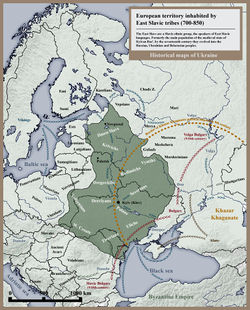East Slavs


The East Slavs are a Slavic ethnic group, the speakers of East Slavic languages. Formerly the main population of the medieval state of Kievan Rus, by the seventeenth century they evolved into the Russian, Ukrainian, and Belarusian[1] peoples.
Contents |
History
Sources

Relatively little is known about the Eastern Slavs prior to approximately 859 AD, the date from which the account in the Primary Chronicle starts. The reasons are the apparent absence of a written language (Cyrillic script, created about 863 was specifically for Slavic adoption) and the remoteness of East Slavic lands. What little is known comes from archaeological digs, foreign traveller accounts of the Rus land, and linguistic comparative analyses of Slavic languages.

Very few native Rus' documents dating before the 11th century (none ante-dating the 10th century) have been discovered. The earliest major manuscript with information on Rus' history is the Primary Chronicle, written in the late 11th and early 12th centuries. It lists the twelve Slavic tribal unions who, by the 9th century settled between the Baltic Sea and the Black Sea. These tribal unions were Polans, Drevlyans, Dregovichs, Radimichs, Vyatichs, Krivichs, Slovens, Dulebes (later known as Volhynians and Buzhans), White Croats, Severians, Ulichs, Tivertsi.
Migration

There is no consensus among scholars as to the urheimat of the Slavs. In the first millennium AD, Slavic settlers are likely to have been in contact with other ethnic groups who moved across the East European Plain during the Migration Period. Between the first and ninth centuries, the Sarmatians, Huns, Alans, Avars, Bulgars, and Magyars passed through the Pontic steppe in their westward migrations. Although some of them could have subjugated the region's Slavs, these foreign tribes left little trace in the Slavic lands. The Early Middle Ages also saw Slavic expansion as an agriculturist and beekeeper, hunter, fisher, herder, and trapper people. By the 8th century, the Slavs were the dominant ethnic group on the East European Plain.
By 600 AD, the Slavs had split linguistically into southern, western, and eastern branches. The East Slavs practiced "slash and burn" agricultural methods which were well-suited to the endless forests in which they settled. This method of agriculture involved clearing tracts of forest with fire, cultivating it and then moving on after a few years. Slash and burn agriculture requires frequent movement, because soil cultivated in this manner only yields good harvests for a few years before exhausting itself, and the reliance on slash and burn agriculture by the East Slavs explains their rapid spread through eastern Europe. [2] The East Slavs flooded Eastern Europe in two streams. One group of tribes settled along the Dnieper river in what is now Ukraine,and Beylorussia to the North; they then spread northward to the northern Volga valley, east of modern-day Moscow and westward to the basins of the northern Dniester and the Southern Buh rivers in present-day Ukraine and southern Ukraine.
Another group of East Slavs moved from Pomerania to the northeast, where they encountered the Varangians of the Rus' Khaganate and established an important regional centre of Novgorod. The same Slavic population also settled the present-day Tver Oblast and the region of Beloozero. Having reached the lands of the Merya near Rostov, they linked up with the Dnieper group of Slavic migrants.
Pre-Kievan period

In the eighth and ninth centuries, the south branches of East Slavic tribes had to pay tribute to the Khazars, a Turkic-speaking people who adopted Judaism in the late eighth or ninth century and lived in the southern Volga and Caucasus regions. Roughly in the same period, the Ilmen Slavs and Krivichs were dominated by the Varangians of the Rus' Khaganate, who controlled the trade route between the Baltic Sea and the Byzantine Empire.
The earliest tribal centres of the East Slavs included Novgorod, Izborsk, Polotsk, Gnezdovo, and Kiev. Archaeology indicates that they appeared at the turn of the tenth century, soon after the Slavs and Finns of Novgorod had rebelled against the Norsemen and forced them to withdraw to Scandinavia. The reign of Oleg of Novgorod in the early tenth century witnessed the return of the Varangians to Novgorod and relocation of their capital to Kiev on the Dnieper. From this base, the mixed Varangian-Slavic population (known as the Rus) launched several expeditions against Constantinople.
At first the ruling elite was primarily Norse, but it was rapidly Slavicized by the mid-century. Sviatoslav I of Kiev (who reigned in the 960s) was the first Rus ruler with a Slavonic name.
Modern East Slavs
Modern East Slavic peoples and ethnic groups include:
- Belarusians
- Poleszuks
- Russians
- Pomors
- Lipovan Russians
- Ukrainians
- Poleszuks
- Hutsuls
- Bojkos
- Lemkos
- Rusyns
Gallery
 Three generations of a Russian family, ca. 1910 |
 1961 USSR postage stamp depicting Belarusian traditional costumes |
 Ukrainians in traditional dress |
 Ukraine country atmosphere; ukrainian postcard. |
See also
- List of early East Slavic states
References
- ↑ Encyclopedia Britannica On-line
- ↑ Richard Pipes. (1995). Russia Under the Old Regime. New York: Penguin Books. pp. 27-28
- Г.В.Вернадский Древняя Русь http://www.erlib.com/Георгий_Вернадский/Древняя_Русь/1;
http://gumilevica.kulichki.net/VGV/vgv1.htm; http://www.rodstvo.ru/rus/hist/ver1.htm и др.
 This article incorporates public domain material from websites or documents of the Library of Congress Country Studies. - Russia
This article incorporates public domain material from websites or documents of the Library of Congress Country Studies. - Russia
|
|||||||||
|
|||||||||||||||||||||||||||||

.jpg)
